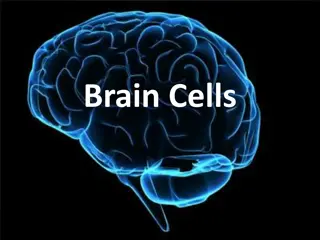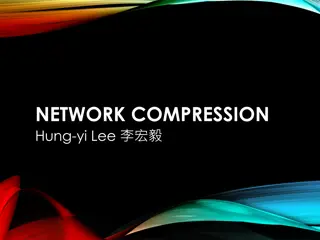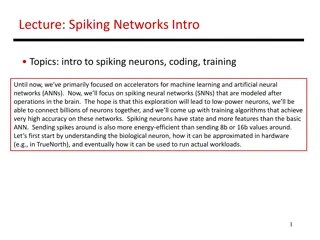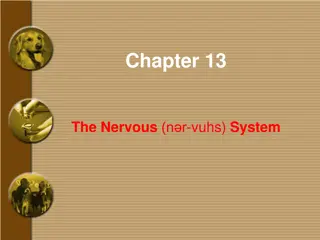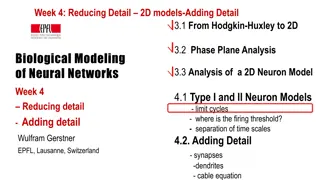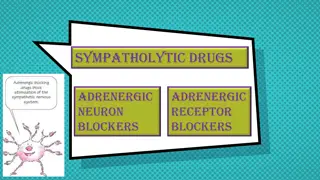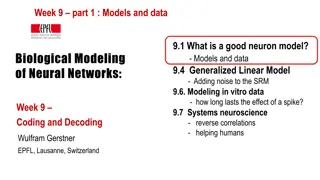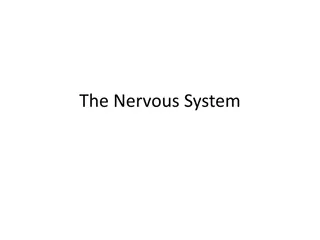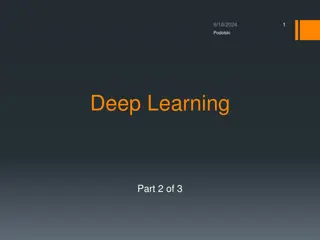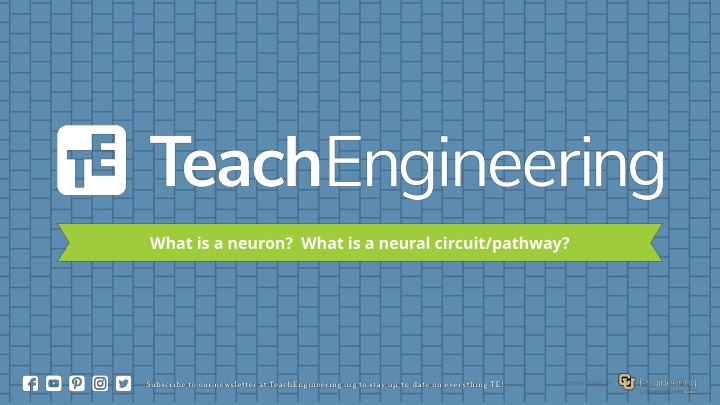
Neurons and Neural Circuits: A Brief Overview
Explore the functions of neurons and neural pathways in the transmission of electrical signals in the brain. Learn how neurons receive inputs, process information, and produce outputs through action potentials.
Download Presentation

Please find below an Image/Link to download the presentation.
The content on the website is provided AS IS for your information and personal use only. It may not be sold, licensed, or shared on other websites without obtaining consent from the author. If you encounter any issues during the download, it is possible that the publisher has removed the file from their server.
You are allowed to download the files provided on this website for personal or commercial use, subject to the condition that they are used lawfully. All files are the property of their respective owners.
The content on the website is provided AS IS for your information and personal use only. It may not be sold, licensed, or shared on other websites without obtaining consent from the author.
E N D
Presentation Transcript
ACTIVITY 1 - Designing Circuits Activity 1.1 Design an electrical circuit to light a bulb, say for a Christmas tree. YOUR CHALLENGE: Go to https://phet.colorado.edu/en/simulations/circuit-construction-kit-dc and click the play button to design the circuit on your own. You will see a palette where you can drag and drop components. Try it until you get the bulb to light up. Hint: You will need a battery, a wire, a resistor, and a light bulb.
SOLUTION for Activity 1.1: Electrical Circuit to Light a Bulb https://phet.colorado.edu/en/simulations/circuit-construction-kit-dc 3
What is a neuron? What is a neural pathway/circuit? For a quick description of a neuron, check out this video https://www.youtube.com/watch?v=6qS83wD29PY Neurons are specialized cells responsible for receiving and processing inputs from other neurons and sensory receptors to deliver an output to neighboring neurons or muscles. Later, we will show how a neuron is an electrical device with its own electrical battery powered by biology. Viewing and responding to a visual stimulus is a process involving many neurons communicating information from the eyes to the brain and then to the muscles. The next set of slides concerns the structure of a single neuron and how its structure enables it to transmit information. And then check out this video about a neuron: https://www.youtube.com/watch?v=Vf8Ooyzkj_s Optional: If you want to know more details, try these: https://www.youtube.com/watch?v=FssFyeKRCic and https://www.youtube.com/watch?v=HZh0A-lWSmY 4
Receiving Inputs Neurons receive information from other neurons through dendrites. Dendrites are extensions of the cell body that receive inputs through connections with other neurons. The signals received through the dendrites are then passed to the cell body. The signals are integrated (summed) within the axon hillock, the region in the cell body where the axon originates. https://upload.wikimedia.org/wikipedia/commons/thumb/9/9e/Anatomy_of_neuron.png/500px -Anatomy_of_neuron.png 5
Producing an Output If the summation of the signals in the hillock reaches a certain threshold, an action potential is generated and propagated along the axon. Action Potential: A rapid electrical charge that travels down the axon of a neuron. Axon: The long strand extending from the cell body that propagates action potentials toward other neurons. To ensure fast, reliable transmission across the axon, the axon is insulated with segments of myelin. Myelin Sheath: Myelin coating surrounding the axon to speed up and insulate signals travelling through the axon. Speed: The signal "jumps" the gaps between myelin sheaths rather than flowing continuously (saltatory conduction). Signal integrity: The insulation prevents degradation of the signal as it travels through the axon. https://upload.wikimedia.org/wikipedia/commons/thumb/9/9e/Anatomy_of_neuron.png/500px -Anatomy_of_neuron.png 6
Connecting to another neuron and passing on the electrical impulse The electrical impulse ultimately arrives at the axon terminals, the endpoints of the axon. Here, the terminals pass the output to neighboring neurons through gaps known as synapses. https://upload.wikimedia.org/wikipedia/commons/thumb/9/9e/Anatomy_of_neuron.png/500px -Anatomy_of_neuron.png 7
https://en.wikipedia.org/wiki/Lobes_of_the_brain Brain has lots of circuits/pathways The mammalian brain contains almost 100 billion neurons that control all the functions you perform each day! And they control all the organs in your body, much as the computer controls many functions in a car. The brain is divided into four main lobes: the frontal lobe, the parietal lobe, the temporal lobe, and the occipital lobe. The region we will be focusing on is the amygdala, located in the temporal lobe, which is the fear center of our brain. That is, you learn fear using the amygdala, and it also stores various types of fear. Lobes of the cerebral cortex (right hemisphere view) https://en.wikipedia.org/wiki/Limbic_system#/media/File:Limbic_lobe_hariadhi.svg 8
Concept of firing rate in cycles/second or Hertz 1. **Pendulum Swing**: Imagine a pendulum swinging back and forth. One complete swing from one direction to the other and back again is one cycle. If it takes one second to complete this swing, it's one cycle per second or 1 Hertz. You can vary the length of the pendulum, or the force applied, to change the frequency (cycles per second) of its swing. 2. **Sound Waves**: Sound travels in waves, and its frequency is measured in Hertz. For instance, a tuning fork vibrating at 440 Hz produces the musical note A. This means the air particles around the tuning fork vibrate back and forth 440 times per second, creating the sound we hear. 3. **Electrical Devices**: The frequency of alternating current (AC) in power lines is typically 50 or 60 Hz. This frequency means that the electric current changes its direction 50 or 60 times per second. 4. **Heart Rate**: Heart rate is measured in beats per minute (bpm), which is related to cycles per second. If a person's heart beats at 60 beats per minute, it means their heart contracts and relaxes (completing one cycle) 60 times in one minute, which translates to 1 Hz or 1 cycle per second. 5. **Bicycle Wheels**: The rotations of a bicycle wheel also illustrate cycles per second. If a wheel completes, say, two full rotations in one second, then it's rotating at 2 Hz or 2 cycles per second. These examples (generated by ChatGPT) can make the concept of cycles per second more tangible, showing how often something repeats or oscillates within a specific time frame. 9
Firing Rates Neurons generate electrical impulses (also called spikes or action potentials) to communicate with other neurons. Neurons keep firing multiple times to move your hand, for instance. This is known as the firing rate of the neuron. Firing rate is measured in frequency of spikes per second, or in Hertz (Hz). The figure below (right) shows the electrical impulses (spikes) generated by the neuron (left). If you count the number of spikes and divide by the time, then you get the firing rate of the neuron in cycles/second or Hertz (Hz). Generated in our Lab https://upload.wikimedia.org/wikipedia/commons/5/51/Hippocampal-pyramidal-cell.png 10
Where else are neurons/pathways located? Neurons are also located in the spinal cord and nerves spread out across the body. The brain and spinal cord make up the central nervous system, while the nerves that branch out from it make up the peripheral nervous system. The nervous system is like two sets of one-way streets. Through one set of nerves, the sensory nerves tell the brain what they sense. Through another set of nerves, the brain tells the muscles (that control your limbs, organs, etc.) to contract or relax, generating movement. https://upload.wikimedia.org/wikipedia/commons/thumb/5/5b/Nervous_system_diag ram-en.svg/290px-Nervous_system_diagram-en.svg.png 11
Now lets look at a neural pathway or neural circuit A neural pathway is responsible for connecting a specific part of the nervous system to another by a bundle of axons (similar to wires in an electrical circuit). In the vision pathway, visual information activates neurons in your eyes and that electric current is carried through the optic nerve to the lateral geniculate nucleus (LGN). That makes the LGN neurons fire, and that current is taken by axons to neurons in the primary visual cortex, which recognizes the object. https://upload.wikimedia.org/wikipedia/commons/thumb/b/bf/Human_visual_pathway.svg/1920px-Human_visual_pathway.svg.png Neural pathway that helps you see an object 12
Activity 1.2 - Sketching a Neuron In this activity, students sketch a neuron to understand structure and functioning. Material List: paper and pencil Activity: Sketch a neuron; make sure to label the parts of both neurons and their function. Write down all you know about a neuron and what it does: Write down all that comes to your mind, including structure, function, etc. 13
Activity 1.3 - Sketching a Neural Pathway In this activity, students sketch a neuron to understand structure and functioning. Material List: paper and pencil Activity: Using the neural pathway for vision in the previous slide, you should now sketch the neural pathway for hearing a tone such as music. You can look up internet sources and conduct your own research into one other neural pathway that may be of interest to you and sketch that on another sheet. 14
Vocabulary words for review CNS: The central nervous system, made up of the brain and the spinal cord. Neuron: The cells of the brain and nervous system responsible for receiving sensory inputs (stimuli) from the external world and generating nerve impulses or electric current if the stimuli are important. Soma: The cell body of a neuron. The other components are dendrite and axon. Dendrite: Processes attached to the soma of the neuron. These processes gather the inputs from other neurons and pass them on to the soma. Action Potential: An electrical impulse (nerve impulse) generated by a neuron based on the inputs it receives via its dendrites. Axon: A wire of a neuron that carries its output, the electric impulses (current), to another neuron. Myelin Sheath: Insulates the axon to allow the electrical impulses to travel faster. Synapse: Connects two neurons permitting one (the pre-neuron) to transmit the electrical impulse to the other (post-neuron). 15
Answers to Activity 1.2 & 1.3 (for teacher) 1.2. SKETCH. Your sketch should include a switch that has the power source (could be a battery also) on one side and wire on the other. The wire is long and connects to the light, and then another wire going back. HOW IT WORKS. The switch connects the power to the wire, the wire carries this electric current to the fluorescent or LED light fixture, and then connects back to the power source. Note that the connection should be complete for the electric current to flow. Then show them the breadboard circuit and how the battery powers the LED, solely for strengthening the concept of circuit/pathway, not the other details (covered later). 1.3. SKETCH. Decision by brain neurons in brain muscles in arm and fingers arm moves up to touch ear HOW IT WORKS. Your decision to move your arm is like the switch in the previous circuit. Once you do that, neurons in your brain (which are electrical devices that have a power source) fire and produce electric impulses. These electric impulses are carried through your nerves to muscles in your arm and fingers. When a muscle receives an electrical impulse, it contracts and move your arm to reach your ear. Similarly, the muscles in your fingers are also driven by neurons.


